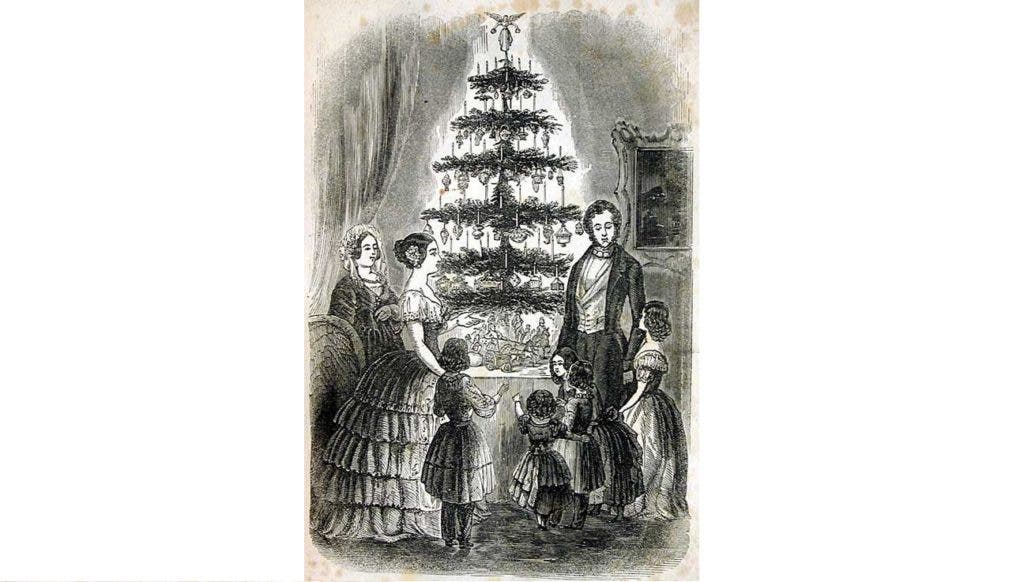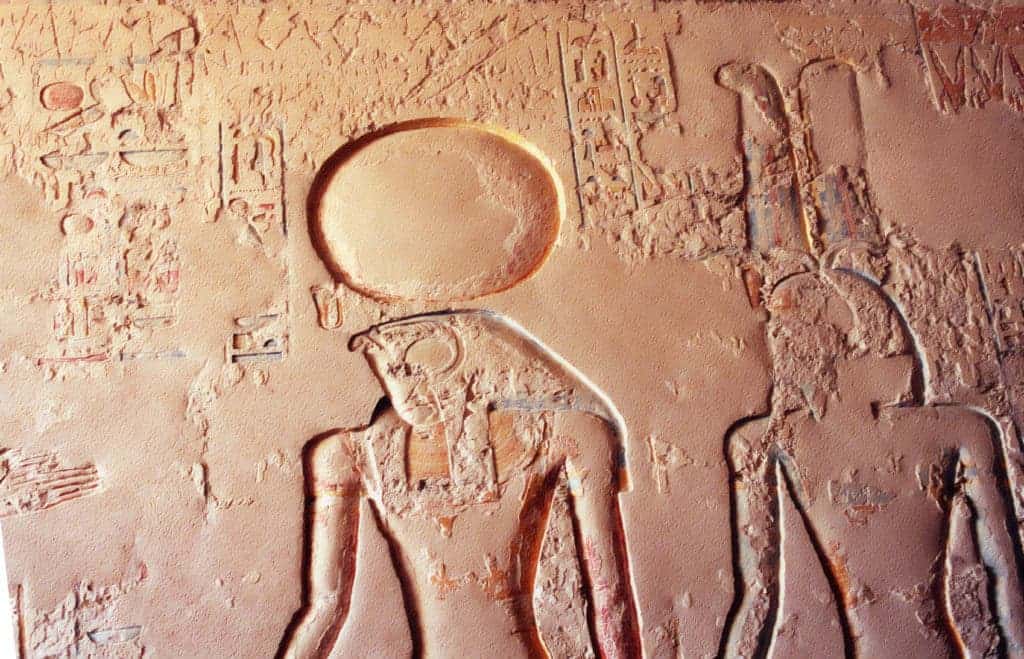
For many, it’s unthinkable to celebrate Christmas without a beautiful evergreen fir in the living room decorated with sparkling ornaments and wrapped presents. Like most Christmas traditions, including the celebration of Christmas itself, the origin of the Christmas tree can be traced to pagan traditions. Basically, the Christmas tree is entirely pagan.
In fact, were it not for Queen Victoria (the most powerful monarch of her time) and a group of German soldiers in a temporary hospital in England, the decorated fir trees we love today might have remained an obscure custom that only a couple of Germanic and Slavic countries practiced.
Pagan origins of the Christmas tree

Although the Christmas tree is a relatively recent addition to the list of holiday traditions, it goes back several centuries, as do many other customs.
Long before Christianity appeared, people in the Northern Hemisphere used evergreen plants to decorate their homes, particularly the doors, to celebrate the Winter Solstice. On December 21 or December 22, the day is the shortest, and the night is the longest. Traditionally, this time of the year is seen as the return in strength of the sun god who had been weakened during winter — and the evergreen plants served as a reminder that the god would glow again and summer was to be expected.
The solstice was celebrated by the Egyptians who filled their homes with green palm rushes in honor of the god Ra, who had the head of a hawk and wore the sun as a crown. In Northern Europe, the Celts decorated their druid temples with evergreen boughs which signified everlasting life. Further up north, the Vikings thought evergreens were the plants of Balder, the god of light and peace. The ancient Romans marked the Winter Solstice with a feast called Saturnalia thrown in honor of Saturn, the god of agriculture, and, like the Celts, decorated their homes and temples with evergreen boughs.
It’s worth mentioning at this point that Saturnalia was the most important celebration in Roman life. It was a week-long, rowdy celebration held from the 17th of December. It was so wordy that at some point, no one could be prosecuted for injuring or killing people, raping, theft — anything usually against the law. But although a lot of people blew off steam by taking advantage of the lawlessness, Saturnalia could also be a time for kindness. During Saturnalia, many Romans practiced merrymaking and the exchange of presents — another practice you may find familiar.
In the early days of Christianity, the birth of Jesus was set on the last day of Saturnalia by the first Christian Romans in power to approach pagans, even though some scholars assert Jesus was born nine months later, or a few years earlier, but that’s not a point. It was a clever political ploy, some say, which in time transformed Saturnalia from a frat party marathon into a meek celebration of the birth of Christ.
While a lot of ancient cultures used evergreens around Christmas time, historical records suggest that the Christmas tree tradition was started in the 16th century by Germans who decorated fir trees inside their homes. In some Christian cults, Adam and Eve were considered saints, and people celebrated them on Christmas Eve.
During the 16th century, the late Middle Ages, it was not rare to see huge plays being performed in open air during Adam and Eve day, which told the story of creation. As part of the performance, the Garden of Eden was symbolized by a “paradise tree” hung with fruit. The clergy banned these practices from public life, considering them acts of heathenry. So, some collected evergreen branches or trees and brought them to their homes, in secret.
These evergreens were initially called ‘paradise trees’ and were often accompanied by wooden pyramids made of branches held together by rope. On these pyramids, some families would fasten and light candles, one for each family member. These were the precursors of modern Christmas tree lights and ornaments, along with edibles such as gingerbread and gold-covered apples.
Already, a link between trees and Christmas was becoming established. But another key religious figure played a role here.
Some say the first to light a candle atop a Christmas tree was Martin Luther. Legend has it, late one evening around Christmas time, Luther was walking home through the woods when he was struck by the innocent beauty of starlight shining through fir trees. Wanting to share this experience with his family, Martin Luther cut down a fir tree and took it home. He placed a small candle on the branches to symbolize the Christmas sky.
What’s certain is that by 1605, Christmas trees were a thing as, in that year, historical records suggest the inhabitants of Strasburg ‘set up fir trees in the parlors… and hang thereon roses cut out of many-colored paper, apples, wafers, gold-foil, sweets, etc.’
During these early days of the Christmas tree, many statesmen and members of the clergy condemned their use as a celebration of Christ. Lutheran minister Johann von Dannhauer, for instance, complained that the symbol distracted people from the “true evergreen tree” — Jesus Christ. The English Puritans condemned several customs associated with Christmas, such as the use of the Yule log, holly, and mistletoe. Oliver Cromwell, the influential 17th-century British politician, preached against the “heathen traditions” of Christmas carols, decorated trees, and any joyful expression that desecrated “that sacred event.”
They were largely successful, and the Christmas tree remained a niche celebration. Until Queen Victoria came along.
The modern Christmas Tree
In 1846, Queen Victoria and her German husband Albert were sketched in the Illustrated London News standing with their children around a Christmas tree at Windsor Castle. German immigrants had brought the custom of Christmas trees to Britain with them in the early 1800s but the practice didn’t catch on with the locals.
But after Queen Victoria, an extremely popular monarch started celebrating Christmas with fir trees and presents hung on the branches as a favor to her husband, the layfolk immediately followed suit.
Across the ocean, in the 19th century, Christmas trees weren’t at all popular, though Dutch and German settlers introduced them. Americans were less susceptible to the Queen’s influence. However, it was American civic leaders, artists, and authors who played on the image of a happy middle-class family exchanging gifts around a tree to replace Christmas customs that were seen as decadent, like wassailing. This family-centered image was further amplified by a very popular poem written by Clement Moore in 1822 known as “Twas the Night Before Christmas”. The same poem conjured the modern picture of Santa Claus.
It took a long time before the Christmas tree became an integral part of American life during this faithful night. President Franklin Pierce (1804-1869) arranged to have the first Christmas tree in the White House, during the mid-1850s. President Calvin Coolidge (1885-1933) started the National Christmas Tree Lighting Ceremony on the White House lawn in 1923.
Though traditionally not all Christian cultures adorned their homes with evergreens and presents, the influence exerted by the West and rising consumerism has turned the Christmas tree into a ubiquitous symbol. Many people of other faiths have adopted the Christmas tree (See Japan for instance).
The Christmas tree has gone a long way from its humble, pagan origins, to the point that it’s become too popular for its own good. In the U.S. alone, 35 million Christmas trees are sold annually, joined by 10 million artificial trees, which are surprisingly worse from an environmental perspective. Annually, 300 million Christmas trees are grown in farms around the world to sustain a two-billion-dollar industry, but because these are often not enough, many firs are cut down from forests. This is why we recommend opting for more creative and sustainable alternatives to Christmas trees.



